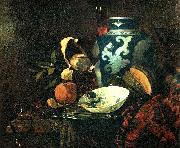
|
Willem Kalf
|
|||
|
|
|||
| 1619-1693 Dutch Willem Kalf Galleries Willem Kalf was born in Rotterdam, in 1619. He was previously thought to have been born in 1622, but H. E. van Gelder??s important archival research has established the painter??s correct place and date of birth. Kalf was born into a prosperous patrician family in Rotterdam, where his father, a cloth merchant, held municipal posts as well. In the late 1630s, Willem Kalf travelled to Paris and spent time in the circle of the Flemish artists in Saint-Germain-des-Pr??s, Paris. In Paris he painted mainly small-scale rustic interiors and still-lifes. Kalf??s rustic interiors are typically dominated by groups of vegetables, buckets, pots and pans, which he arranged as a still-life in the foreground (e.g. Kitchen Still-life, Dresden, Gemäldegal; Alte Meister). Figures usually appeared only in the blurred obscurity of the background. Though painted in Paris, those pictures belong to a pictorial tradition practised primarily in Flanders in the early 17th century, by such artists as David Teniers the Younger. The only indication of the French origin of the paintings are a few objects that Flemish exponents of the same genre would not have pictured in their works. Kalf??s rustic interiors had a large influence on French art in the circle of the Le Nain brothers. The semi-monochrome still-lifes which Kalf created in Paris form a link to the banketjes or 'little banquet pieces' painted by such Dutch artists as Pieter Claesz, Willem Claeszoon Heda and others in the 1630s. During the 1640s, Kalf further developed the banketje into a novel form of sumptuous and ornate still-life (known as pronkstilleven), depicting rich groupings of gold and silver vessels. Like other still-lifes of this period, these paintings were usually expressing vanitas allegories. | |||
|
|
|||
|
stillleben new22/Willem Kalf-543276.jpg Painting ID:: 67356 |
se | ||
|
|
|||
|
Jan Jansz. Treck
|
|||
|
|
|||
| (1606, Amsterdam, 25 September 1652 ) was a still-life painter during the Dutch Golden Age. Treck used economy in the number of his objects. In 1623 Treck was trained for half a year by Jan den Uyl, who had married his sister Geertruid in 1619. His style also shows influence by Pieter Claesz and Willem Heda. In 1643 and 1644 Treck was trained by Abraham Jansz for 4 guilders a week, but forgot to pay for his apprenticeship. He also had to pay for a window that was made to get more light, while working. His earliest known signed and dated work is from 1641, after the death of Den Uyl. A work has surfaced with both signatures, implying that Treck perhaps finished Den Uyl's paintings after his death. Treck also had helped his brother-in-law to sell his house (on Singel) in 1639. After the death of his friend Abraham, Treck bought his equipment, paint and easel. In 1640 he supplied the art dealer Hendrick Uylenburgh with money. After Treck's death his brother, sister and his niece and nephews inherited a small house in an alley from Singel to Spuistraat, furniture, clothes, stocks, coins, jewelry, prints and paintings. In 1661 Simon Luttichuys was asked to repaint a vanitas done by Treck. Treck influenced Pieter van Anraedt and Willem Kalf. | |||
|
|
|||
|
Stillleben new25/Jan Jansz. Treck-653597.jpg Painting ID:: 87740 |
Oil on panel 82 x 69 cm 1637(1637) cjr | ||
|
|
|||
|
Jan Davidsz. de Heem
|
|||
|
|
|||
| stilllife masters, Dutch Baroque Era Painter, 1606-C.1683 | |||
|
|
|||
|
Stillleben new26/Jan Davidsz. de Heem-785558.jpg Painting ID:: 97581 |
1642(1642) Medium oil on canvas Dimensions 46 x 58 cm cyf | ||
|
|
|||
|
Also Buy::. For Following Paintings / Artists / Products, Please Use Our Search Online: |










